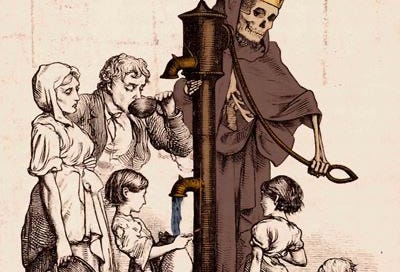For centuries, the prevailing belief in the origins of disease was rooted in the miasma theory, a concept that attributed illnesses such as cholera, the Black Death, and other epidemic diseases to "bad air" or miasmas—noxious vapours thought to emanate from decaying organic matter. This theory was deeply embedded in the medical and cultural understanding of the time, with its origins tracing back to ancient Greek and Roman medical thought. Influential figures such as Hippocrates and Galen, whose writings dominated medical knowledge for centuries, propagated the idea that imbalances in the body's humours, influenced by the environment and air quality, were responsible for disease.
The miasma theory offered a seemingly logical explanation for the spread of diseases in densely populated and unsanitary urban environments, where foul smells from waste, decaying vegetation, and stagnant water were prevalent. The presence of these odours was believed to be indicative of harmful vapours that could infiltrate the body and cause illness. As a result, it was thought that improving air quality by removing or masking these odours could prevent disease.
This belief was not just a medical theory but a deeply ingrained part of public health policy and practice. Across Europe, particularly during the Renaissance and into the Enlightenment, miasma theory informed the design of cities, the management of public spaces, and responses to epidemics. During the Black Death in the 14th century, for example, people burned aromatic herbs, carried posies of flowers, or used vinegar to purify the air they breathed, in the hope of protecting themselves from the deadly plague. In later centuries, the construction of wide boulevards and parks in cities like Paris was partly motivated by the desire to disperse and neutralise harmful miasmas.
The persistence of the miasma theory into the 19th century illustrates the profound influence it had on society, shaping not only medical practice but also urban planning, sanitation efforts, and even personal hygiene. Public health measures during cholera outbreaks in the 19th century, for instance, often focused on cleaning streets, removing refuse, and draining swamps to eliminate the supposed sources of miasmas. While these actions sometimes had beneficial effects, such as reducing the spread of disease by improving sanitation, they were based on a fundamentally flawed understanding of disease transmission.
The miasma theory's dominance also hindered the acceptance of alternative explanations for disease. Early observations and evidence that pointed to the role of microorganisms in disease transmission were often dismissed or ignored because they conflicted with the established belief in miasmas. This resistance to new ideas highlights the challenge of shifting deeply held scientific paradigms and the importance of evidence-based inquiry in advancing medical knowledge.
The eventual decline of miasma theory, replaced by the germ theory of disease in the late 19th century, marked a significant turning point in medical science. However, the legacy of miasma theory remains evident in the history of public health, reminding us of the ways in which cultural and scientific beliefs shape our responses to health crises and influence the evolution of medical practices.The Origins and Persistence of Miasma Theory
The miasma theory's origins can be traced back to the writings of ancient Greek physicians like Hippocrates and Roman scholars such as Galen, who believed that foul-smelling air from swamps, rotting vegetation, and other sources of decay could spread diseases. This theory was a logical extension of the limited scientific understanding of the time, when the mechanisms of disease transmission were largely unknown. The theory gained traction because it provided a straightforward explanation for the occurrence of epidemics, particularly in overcrowded and unsanitary urban areas where bad smells were prevalent.
Throughout the Middle Ages and into the Renaissance, miasma theory remained the dominant explanation for the spread of disease. The notion that diseases were transmitted through the air by foul odours was accepted by both the medical community and the general public. During outbreaks of the plague, for example, it was common for people to carry fragrant herbs or wear masks filled with aromatic substances, believing that these measures would protect them from the "bad air" that carried the disease.
Influence on Public Health and Sanitation
The belief in miasmas had a profound influence on public health practices. Since miasmas were thought to be responsible for diseases, efforts to prevent and control outbreaks focused on eliminating sources of foul odours and improving sanitation. This led to initiatives such as the cleaning of streets, the removal of waste, and the draining of swamps. While these measures were intended to remove the supposed miasmas, they inadvertently contributed to better public health outcomes by reducing the presence of filth and, as a byproduct, improving overall hygiene.
For example, during the cholera outbreaks of the 19th century, particularly in London, authorities took action to clean the streets and improve waste disposal methods in an attempt to rid the environment of disease-causing miasmas. Although these actions were based on a misunderstanding of disease transmission, they had the unintended effect of reducing the spread of cholera by improving water quality and sanitation, as the actual cause of cholera was contaminated water, not bad air.
The Transition to Germ Theory
The transition from miasma theory to germ theory in the late 19th century marked a pivotal moment in the history of medicine. This shift was largely driven by the groundbreaking work of scientists like Louis Pasteur and Robert Koch, whose research provided compelling evidence that microorganisms, not miasmas, were responsible for causing disease.
Louis Pasteur, a French chemist and microbiologist, played a crucial role in challenging the miasma theory. Through his experiments, Pasteur refuted the idea of spontaneous generation—the notion that life could arise from non-living matter—and demonstrated that microorganisms were present in the air and could contaminate sterile solutions, leading to the spoilage of food and the development of diseases. His work on fermentation and pasteurisation further supported the germ theory by showing that specific microorganisms were responsible for biochemical processes and could be controlled to prevent disease.
Building on Pasteur’s discoveries, Robert Koch, a German physician and microbiologist, developed a series of postulates that established a causal relationship between a specific microbe and a disease. Using these postulates, Koch identified the bacteria responsible for diseases such as anthrax, tuberculosis, and cholera. His meticulous methods and undeniable results provided the scientific community with concrete proof that germs, not miasmas, were the true culprits behind many infectious diseases.
The Broad Street Pump and the Birth of Modern Epidemiology
One of the most significant events in the history of public health and epidemiology took place in the East End of London in 1854, during a devastating outbreak of cholera. This event not only challenged the prevailing miasma theory but also marked a turning point in our understanding of disease transmission and the importance of clean water supplies.
The Cholera Outbreak of 1854
In the mid-19th century, cholera was a feared and deadly disease, causing severe diarrhoea, dehydration, and often death within a matter of days. London, with its rapidly growing population and poor sanitation, was particularly vulnerable to outbreaks. At the time, the miasma theory was the dominant explanation for cholera’s spread; it was widely believed that the disease was transmitted through foul-smelling air arising from decomposing matter.
However, a physician named Dr. John Snow was skeptical of the miasma theory. He hypothesised that cholera was actually spread through contaminated water, a radical idea at the time. Snow had been studying cholera for several years and had observed patterns that suggested a link between water sources and the incidence of the disease.
The 1854 cholera outbreak in the Soho district of London provided Dr. Snow with an opportunity to test his theory. Within a short period, the outbreak had claimed the lives of more than 500 people in the area. Snow began a meticulous investigation, mapping the locations of cholera cases and examining the water sources used by the affected population.
Through his investigation, Snow identified a significant concentration of cholera cases around the Broad Street water pump, a public water source that many local residents relied on for drinking water. He observed that people who lived closer to the pump or who regularly drank its water were more likely to contract cholera. In contrast, those who used other water sources were less affected.
To strengthen his case, Snow also noted that workers at a nearby brewery, who drank beer instead of water, were largely spared from the disease. Additionally, he found that inmates of a workhouse situated near the outbreak but with its own water supply also remained unaffected. These observations further supported Snow’s hypothesis that contaminated water, not miasmas, was responsible for the spread of cholera.
Convinced that the Broad Street pump was the source of the outbreak, Dr. Snow approached the local authorities and persuaded them to remove the pump handle, effectively disabling the pump and preventing people from accessing its water. After the pump was disabled, the number of new cholera cases in the area rapidly declined, providing compelling evidence that the water from the pump was indeed the source of the contamination.
Further investigation revealed that the well supplying the Broad Street pump was located near a cesspit, which had leaked faecal matter contaminated with cholera bacteria into the water supply. This contamination was the true cause of the outbreak, confirming Snow’s theory that cholera was waterborne.
The Legacy of the Broad Street Pump Incident
The removal of the Broad Street pump handle and the subsequent decline in cholera cases marked a pivotal moment in public health and the field of epidemiology. Although the miasma theory remained influential for some time after, Snow’s work laid the groundwork for the eventual acceptance of the germ theory of disease. His methods—using mapping, data collection, and careful observation to trace the source of an outbreak—are now considered foundational to modern epidemiology.
Dr. John Snow’s investigation of the Broad Street pump is often credited with launching the field of epidemiology, the study of how diseases spread within populations. His work demonstrated the importance of clean water supplies and sanitary conditions in preventing disease, leading to significant public health reforms in London and other cities around the world.
The Broad Street pump incident also highlighted the need for better urban infrastructure, particularly in rapidly growing cities. The understanding that cholera and other diseases could be prevented through improved water and waste management systems eventually led to major public health initiatives, including the development of modern sewer systems and the regulation of public water supplies.
Today, the site of the Broad Street pump is commemorated with a plaque and a replica of the pump, serving as a reminder of the importance of scientific inquiry and evidence-based public health practices. Dr. John Snow’s pioneering work continues to inspire public health professionals and epidemiologists, demonstrating the power of careful observation and analysis in protecting public health and saving lives.
The acceptance of germ theory revolutionised both medicine and public health, leading to the development of more effective strategies for preventing and treating infectious diseases. Understanding that cholera was caused by the bacterium *Vibrio cholerae*, which spread through contaminated water, prompted significant improvements in water supply and sanitation systems. These measures drastically reduced the incidence of cholera and other waterborne diseases, particularly in urban environments. The lessons learned from the Broad Street pump incident directly influenced these developments, as urban planners and public health officials began to prioritise clean water and effective waste management.
The shift from miasma to germ theory also paved the way for the development of vaccines and antibiotics, which have saved countless lives. Louis Pasteur, whose work was instrumental in establishing germ theory, developed vaccines for rabies and anthrax, demonstrating the potential of immunisation to prevent disease. The discovery of antibiotics, beginning with Alexander Fleming’s discovery of penicillin in 1928, provided powerful tools for treating bacterial infections that were once deadly. These innovations, rooted in the understanding of germs as the cause of disease, transformed medical practice and led to dramatic reductions in mortality from infectious diseases.
Moreover, the germ theory of disease transformed medical practice by emphasising the importance of hygiene and sterilisation. Hospitals and surgical procedures adopted strict antiseptic techniques to prevent infections, leading to significant reductions in postoperative mortality rates. The understanding of germ transmission also fostered the development of public health initiatives, such as vaccination programs and campaigns to promote hand-washing and other hygiene practices.
During the First World War, the conditions in the trenches were notoriously harsh and unsanitary, leading to the spread of many diseases. However, cholera outbreaks were relatively rare during the war, largely due to improvements in public health knowledge and military efforts to control water sources and waste management.
The armies, particularly on the Western Front, were acutely aware of the dangers posed by waterborne diseases like cholera. The lessons learned from earlier cholera outbreaks, including the importance of clean water and sanitation, influenced military strategies to prevent disease. Chlorination of water supplies, the use of latrines, and the establishment of medical corps dedicated to sanitation were all measures implemented to reduce the risk of cholera and other infectious diseases.
Despite these efforts, other diseases, such as typhus, dysentery, and trench fever, were rampant in the trenches, exacerbated by overcrowding, poor hygiene, and the presence of lice. The overall death toll from disease during the First World War was significant, although cholera was not a major contributor thanks to the preventive measures in place.
The understanding and application of germ theory during this period undoubtedly saved countless lives by preventing large-scale outbreaks of cholera and similar diseases, even in the challenging conditions of wartime.
The Legacy of Miasma Theory
While miasma theory has long been discredited, its influence can still be seen in modern public health practices. The focus on sanitation, waste management, and urban cleanliness—integral components of today’s public health strategies—can trace their roots back to efforts aimed at combating miasmas. Although these practices were initially based on a flawed understanding of disease transmission, they laid a crucial foundation for the development of public health systems that prioritise environmental factors in the prevention of disease.
The legacy of miasma theory is a testament to the enduring impact of historical beliefs on contemporary health practices. It reminds us that the path to scientific understanding is often non-linear, shaped by trial, error, and the gradual accumulation of knowledge. The shift from miasma to germ theory was not just a scientific revolution but also a profound change in how humanity approached the challenge of disease. It highlights the importance of remaining open to new evidence, even when it challenges long-held assumptions.
The story of miasma theory and its eventual replacement by germ theory underscores the dynamic nature of scientific inquiry and the evolution of medical knowledge. It serves as a powerful reminder that our understanding of health and disease is constantly evolving. The pursuit of knowledge—driven by curiosity, rigorous evidence, and the courage to challenge established beliefs—remains at the heart of medical and public health advancements. As we continue to face new and emerging health challenges, the lessons of the past guide us, reminding us of the importance of adaptability, critical thinking, and the relentless quest for truth in safeguarding public health.
















Share this post